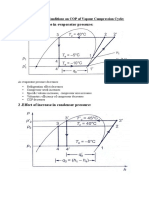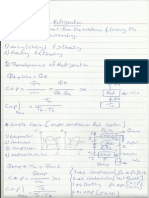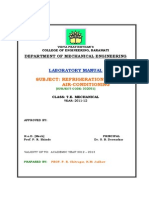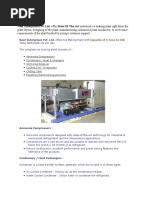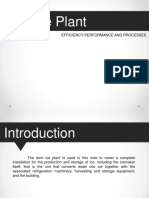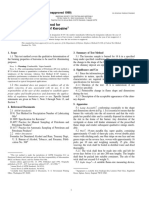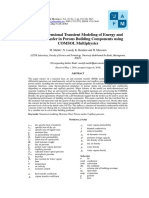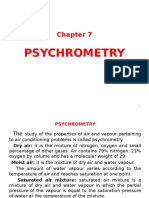Ice Making Plant Visit Report
Ice Making Plant Visit Report
Uploaded by
Anis BadshahCopyright:
Available Formats
Ice Making Plant Visit Report
Ice Making Plant Visit Report
Uploaded by
Anis BadshahOriginal Description:
Copyright
Available Formats
Share this document
Did you find this document useful?
Is this content inappropriate?
Copyright:
Available Formats
Ice Making Plant Visit Report
Ice Making Plant Visit Report
Uploaded by
Anis BadshahCopyright:
Available Formats
REFRIGERATION & AIR CONDITIONING
POF VISIT REPORT
INTRODUCTION:
The demand for block ice is as great today as it ever has been, despite advances made in the development of modern refrigeration equipment. The chemical and construction industries, for example, commonly use block ice in situations where the use of such equipment may not be practical. The fishing industry is also another major consumer of block ice, which is used to preserve the fish from the time they are caught, until they are sold. It is also used to great extents by the retailers of food and drinks to preserve food and/ or chill drinks. Block ice is the most popular type of ice sold for a variety of reasons. It melts more slowly than other types of ice and thus lasts longer. It can be placed in open truck with only a tarpaulin to protect it from the elements and shipped to a location of four hours away. Its rectangular shape makes it easy to stack of up to 15 meters and store large amounts. Block ice has merits of easy to transport and separate as well. Other types of ice have the tendency to freeze into a solid mass, making it difficult to work with. The ice making plant outlined in this proposal is the result of years of research and development done by FRESER. The plant was designed to operate efficiently in tropical areas, but should prove to be profitable in any climate.
PARTS OF ICE MAKING PLANT:
The complete ice making plant consists of:
I. II. III. IV. V. VI.
Ammonia Compressors Condensers / Heat Exchangers Ammonia Receiver Cooling Coil / Evaporator Chilling Tank Paneling (Electrical Equipments) i. AMMONIA COMPRESSORS: Ammonia compressors designed with state-of-the-art technology for industrial & commercial refrigeration and low temperature applications.
1|Page
REFRIGERATION & AIR CONDITIONING
POF VISIT REPORT
Compressors are V belt driven and are suitable to operate with Ammonia (NH3) & Freon [12 (CCl2F2), 22 (CHClF2)] as refrigerant. Robust construction, excellent performance and power saving features and hallmarks of the products. ii. CONDENSERS/HEAT EXCHANGERS:
Condenser is a heat transfer surface, generally which are divided in to three types. Air Cooled Condenser: Employ air as the condensing medium. Water Cooled Condenser: Utilize water to condense the refrigerant. Evaporative Condenser: Use both air and water as the condensing medium. The function of the air is to increase the rate of evaporation by carrying away the water vapor results from evaporation process. iii. AMMONIA RECEIVER: Ammonia receiver can control the supply and demand relation between the condensers and the evaporator, prevent excessive liquid ammonia from staying in the condenser, maintain a certain level in the liquid receiver to prevent gas from going into the liquid pipe line. The ammonia in the system can be stored in the ammonia receiver to avoid loss of the ammonia before the refrigerating system is repaired. Therefore, the volume of the ammonia storage should be considered before buying it. iv. COOLING COIL/EVAPORATOR: Cooling Coil / Evaporator is used as heat transfer surface in which a volatile liquid is vaporized for the purpose of removing heat from refrigerated space. V shape cooling coils are available in different sizes, usually custom made to the individual applications. v. CHILLING TANK:
Chilling Tank consists of three parts: A) Ice Tank
2|Page
REFRIGERATION & AIR CONDITIONING
POF VISIT REPORT
B) Insulation of Ice Tank C) Ice Block A) ICE TANK: Ice tanks are made of such material as wood, steel or concrete. As wooden tanks do not last long enough and are liable to leak, they should preferably be made of steel well coated with waterproof paint. Tanks made of reinforced concrete are also recommended as superior to those of wood. The ice tank contains the direct expansion coils, equally distributed throughout the tank and these coils are submerged in brine. The tank is provided with a suitable frame of hard wood for support the ice cans and a propeller or agitator for keeping the brine in motion: the brine in the tank acts as a medium of contact only, the ammonia evaporating in the ice coils extracts the heat from the brine, which again absorbs the heat for the water in the cans. The tank itself should not be much larger than is necessary to hold the cans, the coils, and the agitator. About two inches should be left between the moulds and three inches between the pipes and the moulds.
B) INSULATION OF TANK: Insulation of the ice tank is accomplished by using twelve to eighteen inches of good insulating material on each of the sides and not less than twelve inches under the bottom. C) ICE BLOCK: Commercial sizes of Ice cans vary with the weight of ice cakes required. The cans are made to contain about 5% more than their rated capacity to compensate for thawing. vi. Paneling (Electrical Equipments) :
The Neer Ice making plant is furnished with electrical control panel with compressor starter, all necessary safety switches and press stats, Voltmeter, Ammeter, Temperature Sensor etc.
3|Page
REFRIGERATION & AIR CONDITIONING
POF VISIT REPORT
CAPACITY, PROCESS CYCLE AND ITS LAYOUT:
Ice cans are placed in can grids and moved to beneath the filling tank which automatically fills each can with proper level of pre-cooled water and then stop. Potable water must be used to make ice intended for human consumption. The cans are then hoisted and carried to the brine tank and immersed inside. The brine, which is a calcium chloride solution kept at a
4|Page
REFRIGERATION & AIR CONDITIONING
POF VISIT REPORT
temperature of -10, is constantly circulated by agitator in order to keep the temperature consistent throughout the tank. Air is blown into the center of the can to induce a swirling motion. This causes any impurities and air bubbles in the water to be collected in the center of cans. Prior to finish freezing, this core is removed by a suction pump and replaced with fresh pre-cooled water. The time required for the water to be frozen varies according to the size of cans being used, 150lbs. block requires 24 hours, 300 lbs. Takes 48 hours. When the ice has completely formed, the grids are lifted up from the brine tank and moved to place in the thawing tank. Using the warm water heats the can, until the ice allowed to be slid out. The block ice is then removed from the can by a can dumper. In POF 150 block per day are going manufactured and mass of each block is 50KG. The capacity of that plant is 3.5 TONS, installed on1981. The empty cans are returned to filling tank for next ice making cycle. The ice is moved to ice storage and stacked by an ice stacker, or it can be delivered to customer right away upon requested.
VAPOUR COMPRESSION REFRIGERATION: Vapor-compression refrigeration is one of the many refrigeration cycles available for use. It has been and is the most widely used method for airconditioning of large public buildings, offices, private residences, hotels,
5|Page
REFRIGERATION & AIR CONDITIONING
POF VISIT REPORT
hospitals, theaters, restaurants and automobiles. It is also used in domestic and commercial refrigerators, large-scale warehouses for chilled or frozen storage of foods and meats, refrigerated trucks and railroad cars, and a host of other commercialandindustrialservices. Oilrefineries, petrochemical and chemical pro cessing plants, and natural gas processing plants are among the many types of industrial plants that often utilize large vapor-compression refrigeration systems. Refrigeration may be defined as lowering the temperature of an enclosed space by removing heat from that space and transferring it elsewhere. A device that performs this function may also be called a heat pump.
The vapor-compression uses a circulating liquid refrigerant as the medium which absorbs and removes heat from the space to be cooled and subsequently rejects that heat elsewhere. Figure 1 depicts a typical, single-stage vapor-compression system. All such systems have four components: a compressor, a condenser, a Thermal expansion valve (also called a throttle valve or Tx Valve), and an evaporator. Circulating refrigerant enters the compressor in the thermodynamic state known as a saturated vapor and is compressed to a higher pressure, resulting in a higher temperature as well. The hot, compressed vapor is then in the thermodynamic state known as a superheated vapor and it is at a temperature and pressure at which it can be condensed with typically available cooling water or cooling air. That hot vapor is routed through a condenser where it is cooled and condensed into a liquid by flowing through a coil or tubes with cool water or cool air flowing across the coil or tubes. This is where the circulating refrigerant rejects heat from the system and the rejected heat is carried away by either the water or the air (whichever may be the case).
6|Page
REFRIGERATION & AIR CONDITIONING
POF VISIT REPORT
The condensed liquid refrigerant, in the thermodynamic state known as a saturated liquid, is next routed through an expansion valve where it undergoes an abrupt reduction in pressure. That pressure reduction results in the adiabatic flash evaporation of a part of the liquid refrigerant. The autorefrigeration effect of the adiabatic flash evaporation lowers the temperature of the liquid and vapor refrigerant mixture to where it is colder than the temperature of the enclosed space to be refrigerated. The cold mixture is then routed through the coil or tubes in the evaporator. A fan circulates the warm air in the enclosed space across the coil or tubes carrying the cold refrigerant liquid and vapor mixture. That warm air evaporates the liquid part of the cold refrigerant mixture. At the same time, the circulating air is cooled and thus lowers the temperature of the enclosed space to the desired temperature. The evaporator is where the circulating refrigerant absorbs and removes heat which is subsequently rejected in the condenser and transferred elsewhere by the water or air used in the condenser. To complete the refrigeration cycle, the refrigerant vapor from the evaporator is again a saturated vapor and is routed back into the compressor.
REFRIGERANTS:
There are three specific types of refrigerants used in refrigeration and airconditioning systems: 1. Chlorofluorocarbons or CFCs, such as R-11, R-12, and R-114 2. Hydrochlorofluorocarbons or HCFCs, such as R-22 or R-123 3. Hydrofluorocarbons or HFCs, such as R-134a. All these refrigerants are "halogenated," which means they contain chlorine, fluorine, bromine, astatine, or iodine. Refrigerants, such as Dichlorodifluoromethane (R-12), Monochlorodifluoromethane (R-22), and Refrigerant 502 (R-502), are called PRIMARY REFRIGERANTS because each one changes its state upon the application or absorption of heat and, in this act of change, absorbs and extracts heat from the area or substance. The primary refrigerant is so termed because it acts directly upon the area or substance, although it may be enclosed within a system. For a primary refrigerant to cool, it must be placed in a closed system in which it can be controlled by the pressure imposed upon it. The refrigerant can then absorb at the temperature ranges desired. If a primary refrigerant were used without being controlled, it would absorb heat from most perishables and freeze them solid.
7|Page
REFRIGERATION & AIR CONDITIONING
POF VISIT REPORT
APPLICATIONS:
Ice Making plants are used in different applications like : Fisheries Hospital Chemical Pharmaceutical Commercially used in different industrial applications
8|Page
You might also like
- Method Statment For Fiber Optic Testing & TerminationDocument7 pagesMethod Statment For Fiber Optic Testing & TerminationAnis Badshah89% (9)
- Design of An Ice Plant and Cold Storage PlantDocument49 pagesDesign of An Ice Plant and Cold Storage Plantakaitotheawesome100% (3)
- Refrigeration and Air-Conditioning by C P Arora 3 EdDocument962 pagesRefrigeration and Air-Conditioning by C P Arora 3 EdDivyank Kumar75% (8)
- A Proposed Design of Ice PlantDocument8 pagesA Proposed Design of Ice PlantNirob Mahmud100% (2)
- Air Cooler Project Report PDFDocument50 pagesAir Cooler Project Report PDFNitin Sakpal73% (15)
- Finance Project Report On Ice Plant PDFDocument13 pagesFinance Project Report On Ice Plant PDFDinesh Kumar50% (2)
- Design and Fabrication of Domestic Refrigeration UnitDocument84 pagesDesign and Fabrication of Domestic Refrigeration UnitMurali Krishnan81% (16)
- Ice PlantDocument53 pagesIce PlantSandeep MagapuNo ratings yet
- Ice Plant DesignDocument10 pagesIce Plant DesignRV RecazaNo ratings yet
- Ice Making Plant Visit ReportDocument8 pagesIce Making Plant Visit ReportAnis Badshah33% (3)
- Heat Exchanger Project Final REPORTDocument43 pagesHeat Exchanger Project Final REPORTAnis Badshah79% (63)
- Ice Plant & Cold StorageDocument4 pagesIce Plant & Cold Storageakaitotheawesome0% (1)
- Mini Ice Plant ReportDocument40 pagesMini Ice Plant ReportCherry Obias100% (1)
- Ice PlantDocument101 pagesIce PlantZa Yon100% (5)
- Ice - Plant - Test - Rig Lab ManualDocument5 pagesIce - Plant - Test - Rig Lab ManualSandeep SainiNo ratings yet
- Mini Ice PlantDocument57 pagesMini Ice PlantAjeet Yadav100% (3)
- Mahatma Gandhi Chitrakoot Gramodaya Vishwavidyalaya: Topic:-Ice Manufacturing ProcessesDocument15 pagesMahatma Gandhi Chitrakoot Gramodaya Vishwavidyalaya: Topic:-Ice Manufacturing Processesanimesh100% (1)
- Market Analysis of ICE FactoryDocument4 pagesMarket Analysis of ICE FactoryParwaiz Ali Jiskani100% (1)
- Cooling Tower Seminar Presentation For Final Year ProjectDocument23 pagesCooling Tower Seminar Presentation For Final Year ProjectKritisundar Garnayak71% (7)
- Ice FactoryDocument28 pagesIce Factoryshani2775% (4)
- Ice Making Plant FactoryDocument7 pagesIce Making Plant FactoryKifayat UllahNo ratings yet
- Sound Detector Circuit Term Project ReportDocument10 pagesSound Detector Circuit Term Project ReportAnis Badshah100% (4)
- Basic of Hvac: Prepared By: Engr. Mark Ivan C. EspinosaDocument26 pagesBasic of Hvac: Prepared By: Engr. Mark Ivan C. EspinosaMark Ivan EspinosaNo ratings yet
- 09 Bottom Hole SamplingDocument14 pages09 Bottom Hole SamplingfarajNo ratings yet
- Consider A Two-Stage Cascade Refrigeration System .Document5 pagesConsider A Two-Stage Cascade Refrigeration System .NaufalNo ratings yet
- Ice Plant Test RigDocument58 pagesIce Plant Test Rigjuned shaikhNo ratings yet
- Performance Test of A Mini Ice Plant (Lecture)Document9 pagesPerformance Test of A Mini Ice Plant (Lecture)Alfred100% (1)
- Mini Ice Plant ReportDocument40 pagesMini Ice Plant ReportLeyzer Malumay100% (1)
- Ice Plant Theory RefrigerationDocument16 pagesIce Plant Theory RefrigerationArnulfo Jose Pi DiNo ratings yet
- Study of Water CoolersDocument4 pagesStudy of Water Coolers01parth0% (1)
- Study of Leak Detection, Evacuation and Charging of RefrigerantDocument2 pagesStudy of Leak Detection, Evacuation and Charging of RefrigerantIndraneel Jadhav50% (2)
- Vapor Compression Cycle: Problems: DR Rabia ShaukatDocument35 pagesVapor Compression Cycle: Problems: DR Rabia ShaukatHafiz AbdulrehmanNo ratings yet
- Water CoolerDocument20 pagesWater CoolerRakesh Reddy50% (4)
- Effect of Operating Conditions On COP of VCRDocument9 pagesEffect of Operating Conditions On COP of VCRSatheesh ChandranNo ratings yet
- Ice Plant ComputationDocument6 pagesIce Plant ComputationGerk100% (1)
- Chapter 6-Multiple Evaporator and CompressorDocument27 pagesChapter 6-Multiple Evaporator and Compressorm_alodat6144No ratings yet
- Ice Plant and Cold Storage DesignDocument24 pagesIce Plant and Cold Storage Designrhey100% (2)
- Ice Plant Design For 900 Tons of Ice Per Day 1Document20 pagesIce Plant Design For 900 Tons of Ice Per Day 1dexterNo ratings yet
- CHAPTER 2 Mini Ice Plant Training Module FinalDocument6 pagesCHAPTER 2 Mini Ice Plant Training Module FinalChristian Diano100% (1)
- Ice - Plant FrickDocument4 pagesIce - Plant FrickFernandoReyesNo ratings yet
- Ice Plant and Cold Storage DesignDocument38 pagesIce Plant and Cold Storage DesignDarren Manuel Tenerife100% (2)
- Air Cooler Project ReportDocument50 pagesAir Cooler Project ReportPravin chavda91% (23)
- Ice Plant and Cold Storage Design (60 TONS OF ICE/day: Submitted To: Engr. Renato A. ArriolaDocument24 pagesIce Plant and Cold Storage Design (60 TONS OF ICE/day: Submitted To: Engr. Renato A. ArriolaJonas Dela PeñaNo ratings yet
- Final Project Report On Domestic RefrigeratorDocument25 pagesFinal Project Report On Domestic RefrigeratorAniket Kalore89% (9)
- Refrigeration & Air Conditioning (1) - Sheets SolutionDocument25 pagesRefrigeration & Air Conditioning (1) - Sheets SolutionMohamed Maher100% (3)
- Refrigeration and Air Conditioning Lab ManualDocument25 pagesRefrigeration and Air Conditioning Lab ManualShalini Manchikatla100% (4)
- Ice Making PlantDocument3 pagesIce Making Plantzohaib bilgrami75% (4)
- Block Ice PlantDocument3 pagesBlock Ice PlantTommy RomanoNo ratings yet
- Basic Civil and Mechanical Engineering Unit V Refrigeration and Airconditioning Support NotesDocument9 pagesBasic Civil and Mechanical Engineering Unit V Refrigeration and Airconditioning Support NotesA.R. Pradeep Kumar100% (1)
- Modification of Solar Water Heater System To Avoid TroubleshootingDocument6 pagesModification of Solar Water Heater System To Avoid TroubleshootingInfogain publication100% (3)
- Design and Fabrication of Solar DryerDocument45 pagesDesign and Fabrication of Solar DryerKms Basheer100% (3)
- Window - Air - Conditioning - Test - Rig Lab ManualDocument6 pagesWindow - Air - Conditioning - Test - Rig Lab ManualSandeep Saini100% (1)
- Block Ice Plants: and The Automatic Ice Making Facilities: Plate Ice, Flake Ice, Tube Ice and Pulp IceDocument6 pagesBlock Ice Plants: and The Automatic Ice Making Facilities: Plate Ice, Flake Ice, Tube Ice and Pulp Icetiaan12345No ratings yet
- Design and Fabrication of An Ice Cube Making MachineDocument7 pagesDesign and Fabrication of An Ice Cube Making MachineJunjun AguirreNo ratings yet
- Air Conditioning PPT of EMEDocument24 pagesAir Conditioning PPT of EMEAbhishek Agrahari100% (2)
- Ice Plant CatDocument4 pagesIce Plant CatNazeeh Abdulrhman AlbokaryNo ratings yet
- Ice Plant Trainer (TD-03) : DescriptionDocument2 pagesIce Plant Trainer (TD-03) : DescriptionAshish VermaNo ratings yet
- Lab 1 Refrigeration CycleDocument8 pagesLab 1 Refrigeration Cycletengku30No ratings yet
- Ice Plant Parts DiagramDocument4 pagesIce Plant Parts Diagramattan5tsui100% (1)
- Yu Ki Myat NoeDocument26 pagesYu Ki Myat NoeThaungShanHtet PalatarNo ratings yet
- Mini Ice PlantDocument28 pagesMini Ice PlantCharlie RamirezNo ratings yet
- Ministory of Education: West Yangon Technological University Department of Mechanical EngineeringDocument30 pagesMinistory of Education: West Yangon Technological University Department of Mechanical EngineeringThaungShanHtet PalatarNo ratings yet
- Water Cooler NewDocument9 pagesWater Cooler NewDebjit DasNo ratings yet
- Myat Noe KhinDocument42 pagesMyat Noe KhinThaungShanHtet PalatarNo ratings yet
- MElab Mini Ice PlantDocument8 pagesMElab Mini Ice PlantKent NabzNo ratings yet
- Article 3 Brine Circulated SystemsDocument46 pagesArticle 3 Brine Circulated Systemsmdalt9180No ratings yet
- Yu Ki Ko KoDocument54 pagesYu Ki Ko KoThaungShanHtet PalatarNo ratings yet
- PuraDyn PresentationDocument6 pagesPuraDyn PresentationAnis BadshahNo ratings yet
- Nebosh International General Certificate: © GWG TrainingDocument34 pagesNebosh International General Certificate: © GWG TrainingAnis Badshah100% (1)
- Syed Anis Badshah: March.2014 To CurrentDocument2 pagesSyed Anis Badshah: March.2014 To CurrentAnis BadshahNo ratings yet
- IGC1 Module1 Foundations in H&S Rev1Document54 pagesIGC1 Module1 Foundations in H&S Rev1Anis BadshahNo ratings yet
- 0707 FDocument45 pages0707 FAnis BadshahNo ratings yet
- Internship Report Services TPT, D-21, & D-24 SHOPS: Submitted ToDocument1 pageInternship Report Services TPT, D-21, & D-24 SHOPS: Submitted ToAnis BadshahNo ratings yet
- Small Arms and Ammunition Factory: C-09 ShopDocument7 pagesSmall Arms and Ammunition Factory: C-09 ShopAnis BadshahNo ratings yet
- Who Inquiry About TobaccoDocument260 pagesWho Inquiry About TobaccoAnis BadshahNo ratings yet
- Intl Summer Scholorly Program Guidelines-2011Document4 pagesIntl Summer Scholorly Program Guidelines-2011Anis BadshahNo ratings yet
- King Fahd University of Petroleum & Minerals Deanship of Scientific ResearchDocument20 pagesKing Fahd University of Petroleum & Minerals Deanship of Scientific ResearchAnis Badshah0% (1)
- Annex B (English) VFDocument1 pageAnnex B (English) VFAnis BadshahNo ratings yet
- Stirling Engine Term Project ReportDocument18 pagesStirling Engine Term Project ReportAnis Badshah75% (4)
- Slider Crank Mechanism Term Project ReportDocument16 pagesSlider Crank Mechanism Term Project ReportAnis Badshah88% (24)
- Photoelasticity ReportDocument11 pagesPhotoelasticity ReportAnis Badshah100% (1)
- Step Pulley Term Project ReportDocument15 pagesStep Pulley Term Project ReportAnis Badshah75% (4)
- How To Fix Your Car AcDocument13 pagesHow To Fix Your Car AcElaineWilliamsNo ratings yet
- Lesson 2: Material Balance CalculationsDocument22 pagesLesson 2: Material Balance CalculationsGmichael TeklayNo ratings yet
- Tutorial RefpropDocument9 pagesTutorial Refpropnici triskoNo ratings yet
- Instruction For Freezer CP-402 MTRIANGEL BRANDDocument9 pagesInstruction For Freezer CP-402 MTRIANGEL BRANDHenry Nicolas Caballero TorresNo ratings yet
- Bryden 2002Document13 pagesBryden 2002SergioNo ratings yet
- Lecture Powerpoints: Physics: Principles With Applications, 7 EditionDocument47 pagesLecture Powerpoints: Physics: Principles With Applications, 7 EditionAlbert WalkerNo ratings yet
- D187 PDFDocument4 pagesD187 PDFJuan Diego ArizabalNo ratings yet
- Keph 1 A 1Document5 pagesKeph 1 A 1Mustafa KhanNo ratings yet
- Frigobar LGDocument18 pagesFrigobar LGbrenda ruanoNo ratings yet
- HT 1Document2 pagesHT 1Gupta GurunadhGuptaNo ratings yet
- Two-Dimensional Transient Modeling of Energy and Mass Transfer in Porous Building Components Using COMSOL MultiphysicsDocument10 pagesTwo-Dimensional Transient Modeling of Energy and Mass Transfer in Porous Building Components Using COMSOL MultiphysicsmanigandanNo ratings yet
- Advanced Thermosciences For Energy EngineeringDocument8 pagesAdvanced Thermosciences For Energy EngineeringYunze ZhangNo ratings yet
- Ariston mtp1912f 81396110201 tb28656 Tech.mDocument8 pagesAriston mtp1912f 81396110201 tb28656 Tech.mHislerNo ratings yet
- JJ207 Thermodynamic Topic 2 First Law of ThermodynamicsDocument34 pagesJJ207 Thermodynamic Topic 2 First Law of ThermodynamicsAh Tiang50% (2)
- 4 3 LMTD With TutorialDocument6 pages4 3 LMTD With Tutorialahmad sofyan afdholiNo ratings yet
- Research On Welding Deformation For Box Girder ofDocument12 pagesResearch On Welding Deformation For Box Girder oframiNo ratings yet
- Condenser CapacitiesDocument49 pagesCondenser CapacitiesAdan Ramirez FacioNo ratings yet
- 4 - Discrete Model-Based Operation of Cooling Tower Based On Statistical AnalysisDocument8 pages4 - Discrete Model-Based Operation of Cooling Tower Based On Statistical AnalysisHoàngViệtAnhNo ratings yet
- Temps de Soutirage EcsDocument17 pagesTemps de Soutirage EcsOmarIsoléNo ratings yet
- Psych Rome TryDocument62 pagesPsych Rome TryMohd Hafiz Ahmad100% (1)
- Submittal Data Sheet YORK ZF ZH ZJ ZR ZT Series PREDATORDocument15 pagesSubmittal Data Sheet YORK ZF ZH ZJ ZR ZT Series PREDATORAbry Di moorNo ratings yet
- A Review of Vacuum Degradation Research and The Experimental Outgassing Research of The Core Material-PU Foam On Vacuum Insulation PanelsDocument6 pagesA Review of Vacuum Degradation Research and The Experimental Outgassing Research of The Core Material-PU Foam On Vacuum Insulation PanelsRavi TejaNo ratings yet
- Ambient TemperatureDocument8 pagesAmbient TemperaturepkvssraoNo ratings yet
- Chiller 2Document41 pagesChiller 2German BelenNo ratings yet
- Grade 8 HousekeepingDocument4 pagesGrade 8 HousekeepingJe Mi MaNo ratings yet
- 42a e ThermodynamicsDocument28 pages42a e ThermodynamicsPeter AdamNo ratings yet
- Refrigeration FormulasDocument8 pagesRefrigeration FormulasAshfaq Ali KhanNo ratings yet

































